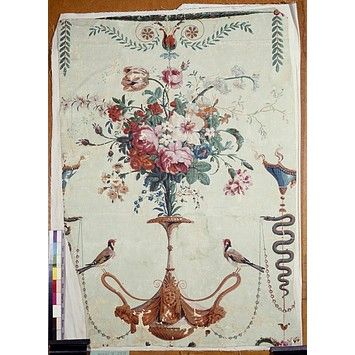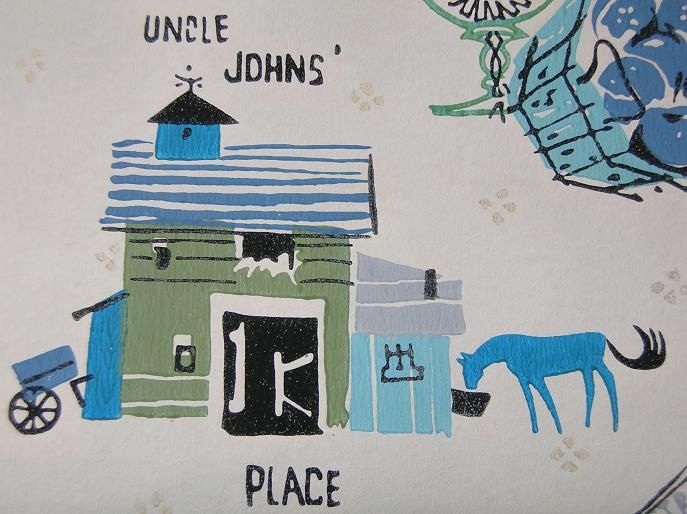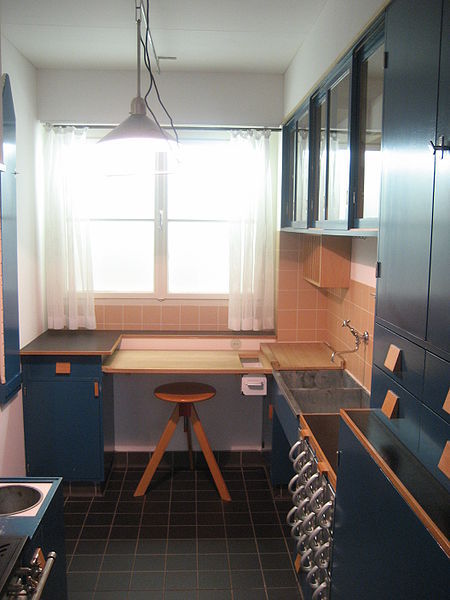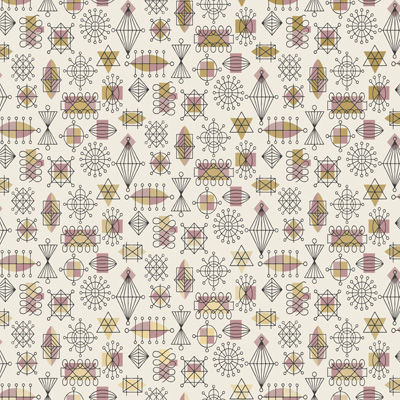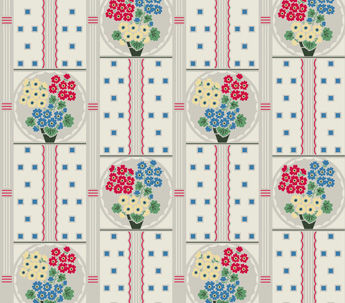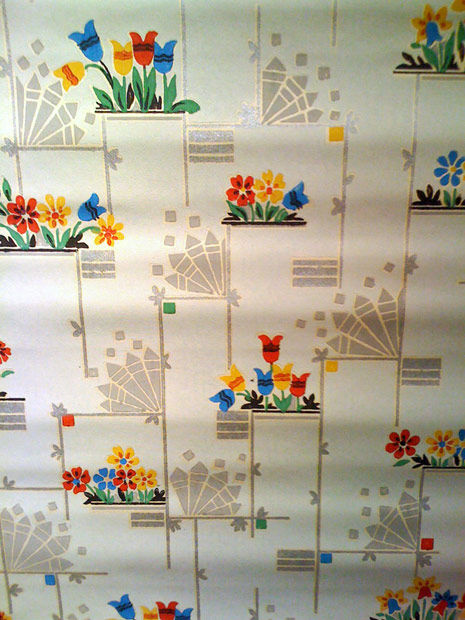Abstracts
Abstract
Kitchen wallpaper is a relatively modern development. The types of images that we associate with kitchen wallpaper—what we now think of as “normal” or “usual” designs—tell us a lot about when it was developed in the early part of the 20th century, particularly the 1920s. Its iconography provides a key to understanding how kitchen design has evolved and how the user of the kitchen has been regarded over time. This article pays particular attention to the development and distribution of kitchen wallpaper in Canada.
Résumé
L’évolution du papier peint dans les cuisines est un phénomène relativement récent. Les images que nous associons au papier peint de cuisine–que nous considérons “normales,” voire “courantes”–témoignent de l’époque où elles se sont développées, à savoir au début du siècle dernier, dans les années 1920. Cette iconographie nous permet de comprendre comment le design des cuisines a évolué et comment les usagers de ce lieu ont été perçus dans le temps. Cet article s’attarde particulièrement au développement et à la distribution des papiers peints au Canada.
Article body
Figure 1
Cover, Good Wallpapers 1923, T. Eaton Co. Ltd., Toronto, 1923. William Colgate History of Printing Collection, Rare Books and Special Collections, McGill University Library
Most of us can readily identify kitchen wallpaper. We recognize it by its depiction of fruits, spices, perhaps some jars or bottles, cute cartoon chefs, or maybe even a nostalgic view of a farm with a cheery barn and happy animals. That these decorations are appropriate for the kitchen seems self-evident—after all, such images relate to what we make, eat, and do in this room. But in a bedroom, we don’t find bed or pyjama-themed wallpaper, and living room wallpaper does not feature televisions or couches, cocktails, or groups of people in conversation. Why is it that the choice of motifs for kitchens is so different?
The short answer is that kitchen wallpaper is a relatively modern development. Although humans have been preparing food in a space in (or near) their dwellings since prehistoric times and wallpaper has existed since the 16th century, Canadian kitchens did not have wallpaper until the 20th century. The types of images that we associate with kitchen wallpaper—what we now think of as “normal” or “usual” designs—tell us a lot about when it was developed in the early part of that century, particularly the 1920s. Its iconography provides a key to understanding not just what’s in the picture today, but how kitchen design has evolved and how the user of the kitchen has been regarded over time.
Wallpaper History
Figure 2
Wallpaper printed by Jean-Baptiste Fay (designer) and Réveillon (manufacturer), Paris, c. 1785-8. Colour print from wood blocks. Collection of the Victoria and Albert Museum, given by Col. Ralph Leeke. Museum number: E17-1916.
Historically, wallpaper was considered a luxury product and was used for decorating rooms of particular importance. Early European designs included patterns adapted from damask fabrics, coats of arms, floral designs, and even sheets with gold or silver leaf. By the 17th century, wallpaper featuring natural scenery was becoming popular. From the growing trade between Europe and the Far East came the influence of Chinese wallpapers, which included scenes with mountains, birds, and flowers; artists also used the designs found on imported Chinese porcelains as inspiration in creating wallpaper designs.[1] Wallpaper was considered a luxury because it was expensive to produce and therefore expensive to buy.
Figure 3
Cowtan wallpaper order book, Cowtan & Son (retailer), London, 1836-41. Book containing cuttings of wallpapers and other materials, mostly colour prints from woodblocks, annotated in ink, and pasted into a volume bound in vellum. Collection of the Victoria and Albert Museum, given by Mr A. L. Cowtan, in memory of his father, Arthur Barnard Cowtan. OBE Museum number: E.1864-1946.
In the 19th century, new manufacturing processes meant that wallpaper could be mass-produced inexpensively, making it affordable for a much larger segment of society. As a result, the wallpaper industry exploded as hundreds of wallpaper companies came into being across North America.[2] Design books such as Clarence Cook’s 1880 What shall we do with our Walls? promoted wallpaper as a way to personalize a home, arguing that “[t]he first practical advantages of wall-paper are, the ease with which it is applied, and the ease with which it is renewed.”[3] City directories indicate that every city or large town had companies selling wallpaper as well as numerous tradesmen available to hang it. Those who lived far from urban centres could buy wallpaper from travelling salesmen or through catalogues: Sears and Montgomery Wards in the United States, Eaton’s and Simpsons in Canada.
Although choosing the best and most appropriate pattern of wallpaper for each room of the house became an increasingly popular topic of discussion throughout the 19th century—both in publications and presumably in conversation—kitchen wallpapers were not initially part of these discussions. While machine-made wallpapers were available to a broad segment of society, they remained delicate and stained easily. Kitchens were deemed inappropriate for anything fragile or susceptible to soiling by smoke, food, or grease. The kitchen was not clean, nor was it thought of as a place where anyone of importance in an upscale household spent any time. It was the realm of the servants in any establishment that could afford them, and servants, it would seem, did not merit wallpaper.
Wallpaper Comes to the Kitchen
Figure 4
Kitchen wallpaper sample, Good Wallpapers 1923, T. Eaton Co. Ltd., Toronto, 1923. William Colgate History of Printing Collection, Rare Books and Special Collections, McGill University Library.
Shortly after the First World War, the idea of using kitchen wallpaper suddenly became popular.[4] At the time, the kitchen was evolving rapidly, with new technologies—electricity, gas, running water—marking a shift in the room’s identity. The post-war kitchen was cleaner and more important to the public life of the household.
The model for the new sanitary and up-to-date kitchen design was, surprisingly enough, the bathroom, which modern technology had already revolutionized in the late 19th century.[5] Bathrooms had moved into the house (from the outhouse) with the development of the flush toilet along with washbasins and bathtubs offering running water. As designs for the room evolved, ceramic tile was used to make the space easier to clean. The wooden cabinetry found in the first bathrooms was replaced by new china and porcelain fixtures and non-porous tile walls.[6]
Unlike the bathroom, which was used by all members of the household, the kitchen remained a more private realm, where only servants and the lady of the house—the manager of the new household—spent time. Thus, designers and decorators suggested, it could serve as a place for experimentation with colours and patterns that might not please other members of the household (that is, the husband): “[t]he kitchen because it is given to dull labor need not be dull. Rather it can better bear the compensation of all those papers that are too strange, too vivid, or too striking to be attempted elsewhere yet on the shop rack look too delightful to pass by.”[7] In other words, the kitchen seemed to be evolving into a place—not unlike historic conceptions of a lady’s boudoir—where a woman could indulge in decorations that were for her benefit alone. Designers relished the opportunity and the freedom to create something new for a room that had previously been off-limits for wallpapers. Not quite carte blanche, but close.
By looking at Canadian wallpaper sample books, we can follow the development of designs for kitchens in the young Dominion. Essentially, what was happening in Canada mirrored the developments in the United States and in Britain; wallpaper sources were primarily regional, which meant that companies in Montreal and Toronto, as well as the national catalogue companies, produced wallpaper catalogues. In a sample book from 1915 produced by The New Empire Wallpaper Company in Toronto, there are no patterns that seem to be expressly designated for the kitchen. An Eaton’s catalogue of 1916, however, offers “Santile Wall Covering,” a washable oil cloth available in several patterns imitating ceramic tile, suggesting that it is suitable for bathrooms, kitchens, pantries, or washrooms. By 1923, the T. Eaton Company’s book of Good Wallpapers included two samples described as being for kitchens and bathrooms. Both mimic tile, but also include a repeating decorative tile in the Dutch fireplace style to enliven the otherwise plain design (Figure 4). Two years later, the same company’s New Wallpaper sample book offers even more choices of wallpapers imitating the look of tile and described as “Clever Tile Effect for Kitchens and Bathrooms” with “gay little scenic touches here and there” that “brighten up those dull walls without delay.”[8] By the 1930s, Canadian sample books no longer specified which wallpaper designs were for which rooms, but it was likely that by then the wise consumer no longer had to be told. The 1936 wallpaper catalogue produced by Dupuis Frères in Montreal includes a number of variations on the “clever tile effect,” but with larger scenic touches showing greater variety: flowers and abstract stained glass. The 1940s brought further variations; the tile motif is only alluded to in many of the designs in the T. Eaton Company catalogue, which features fruits, lace, an elephant knickknack, and vases in bright, cheery colors. Through a type of evolutionary advancement, the look of tile had ceased to be considered essential for kitchen wallpaper.
At the same time that kitchen wallpaper was finding a place in sample books and decorating guides, other decorating authorities, both within and outside the wallpaper trade, still recommended against papering a kitchen. In a 1921 publication on the development of wallpaper, George Whitely Ward observed of the kitchen that “the very best authorities are coincident in opinion that this indispensable apartment should not be papered at all—the first place, for the reason that the steam from the cooking would speedily spoil any paper, even a varnished one; and further, because every bit of grease and fat that flies about will stick to it in perpetuity.”[9] The 1926 trade publication Wallpaper and Wallpaper Hanging by Charles L. Young likewise provides advice for selling wallpaper for every room in the house—except the kitchen.[10]
Other contemporary decorating publications completely avoid discussing kitchens. Articles on wallpaper in Arts and Decoration, an upscale magazine published in New York, reported on new wallpaper designs on a regular basis in the 1930s, but all the designs were for dining rooms, bedrooms, and living rooms. The target audiences for these publications were households where the kitchen remained the realm of the household staff, who still presumably did not deserve cheerful wallpaper. (In the showpieces on new home designs by architects, which are featured in the magazine, the kitchen is never shown.) Even Helen Koues’ On Decorating the House (1928), compiled using information and photos from the more middle-class Good Housekeeping magazine, does not include a chapter on kitchens—even though there is one on “Convenient and Attractive Closets.”[11]
After World War II
Following the end of the Second World War, the wallpaper situation changed yet again, as the kitchen became an important element in home design. In the new post-war suburban house, the kitchen was a centre of activity: not only for cooking, but for eating as well. As a result, it is discussed extensively in magazines and decorating guides. Advances in wallpaper technology meant that new options for washable (and scrubbable) papers were available, and even “wallpaper” for the ceiling.
In Canada, Lillian D. Millar’s 1946 Homes for Canadians (a book based on articles she had published in Canadian Home Journal and Saturday Night), argued that new houses being built for young Canadian families had kitchens that were too small, and that too much activity was concentrated in the only room of adequate size: the living room. According to Millar, the correct place for eating, hobbies, studying, sewing, and presumably cooking was the kitchen.[12] Millar’s solution was to get women more involved in the design process: “[a]s consumers, if women as a whole express disapproval of the new-type house and give a clear-cut picture of what they want, industry will be prodded to respond with something better.”[13] This kitchen was not just for the person who prepared the food, but for everyone, and its decoration therefore had to appeal to the whole family.
Figure 5
Uncle John’s Place wallpaper (KA-2B)
Advancements in technology continued to affect kitchen design. In wallpaper, the development of colours that were resistant to fading by sunlight (“sunworthy”) and new screenprinting and photogravure processes meant that a greater variety of patterns could be produced in smaller quantities.[14] This touched off another explosion in the number of wallpaper designs that were available. For kitchens, which in the new suburban house were places where the whole family might gather, there were now narrative scenes as well as decorative designs. Unlike the grand vistas of earlier scenic wallpapers for salons and drawings rooms, these narrative scenes “like good stories, are intended to hold attention, to intrigue and to delight. By their very nature they are not unobtrusive background patterns intended as a foil for paintings and pictures—they are by themselves the entire wall decoration.”[15] The elephant knickknacks in the 1940s Eaton’s catalogue were perhaps a precursor to narrative patterns, such as the wallpaper with barns and cheery-looking animals that I remember from my grandparents’ Ontario farmhouse, which had been redecorated in the 1950s. The narrative themes seem to have been particularly popular in larger kitchens, where people other than the person making the meal could gather: the type of kitchen promoted by Lillian D. Millar.
Modernism and the Kitchen
Figure 6
Reconstruction of a Frankfurt kitchen in the MAK Vienna.
In 1919, American home economist Christine Fredericks urged that the kitchen should be organized scientifically, like a laboratory or a factory where food could be prepared using less time because of the efficient arrangement of the necessary fixtures and resources.[16] In turn, Margarete Schutte-Lithosky used Fredericks’ idea in designing what would be called the Frankfurt Kitchen, a modest, functional space created in 1927 for a public housing development by architect Ernst May in Frankfurt, Germany.[17] The emphasis was on making the small space look as uncluttered and clean as possible. Schutte-Lithosky used tiles as a backsplash and plain colours on the cabinets and the walls in her influential and well-publicized design.
After World War II, as kitchens became a part of the house worth illustrating in architecture and interior design magazines, the new designs of European modernist architects were appearing alongside more domestic, traditional, and busy kitchen designs. Looking back, the wallpaper-or-no-wallpaper debate looks like a class war; upscale kitchens were wallpaper-free. Designers were influenced not only by the modest Frankfurt kitchen but also by the work of architects such as Le Corbusier, Walter Gropius, and other European modernists who became tastemakers and trendsetters for high-end design. As architectural ideals were transmitted through periodicals, forward-thinking architects and designers everywhere learned that these master practitioners were not using wallpaper.
Thus for high-end clients who had been the target audience for Arts and Decoration before World War II, kitchen wallpaper never seemed to get a foothold in their design world. At a point when kitchens were starting to be shown as essential design elements in house plans—rather than just a necessity on a par with the bathroom—and indeed as a selling point for the modern homeowner, the upscale kitchen was increasingly influenced by minimal modernist design. This did not mean that kitchen wallpaper disappeared entirely. Certain decorating books continued to promote it. Carlson Wade’s 1997 Wall Decorating echoes the sentiment of Phyllis Ackerman’s 1923 decorating book by saying “[y]ou want to create a kitchen that truly reflects your needs and personality. Today’s kitchen should be friendly and efficient with color and pattern.”[18] Wade sees no problem with putting busy patterns in a small kitchen, noting for example that the “white ground [of a gold and blue pattern] ‘opens up’ this rather small room.”[19]
The Contemporary Kitchen
Where does this leave kitchen wallpaper? It continues to be widely available, but seems stuck in the iconography of the 1920s to the 1940s: fruit, flowers, and cute designs suggesting nostalgia for a bygone era. High-end kitchen design ads simply do not show kitchens with wallpaper, which has come to be seen as old-fashioned.
Figures 7 and 8
Examples of wallpaper available in retro designs
In effect, kitchen wallpaper’s period of being truly fashionable was very brief. After the First World War, it was widely available, but by the time kitchens became spaces worthy of magazine articles about high-style design, it was largely out of fashion. In looking at kitchen wallpaper in the present day, we are effectively looking back in time. Although kitchens are often the focus of house design and renovation articles, wallpaper is rarely (if ever) presented as an option for the first-class kitchen renovation, except where the design is purposefully harking back to the 1920s or 1930s.[20] Specialty retailers do carry kitchen wallpaper and Bradbury and Bradbury, an upscale source for art wallpapers, now makes reproductions of classic kitchen wallpapers (see Figures 7 and 8); vintage wallpaper stores also have a selection of original designs that they offer to clients who want the real thing (Figures 9 and 10).
Figure 9
Vintage wallpaper from the 1920s
Figure 10
Vintage wallpaper from the 1950s and 1960s
Kitchen wallpaper has taken on a particular iconographic meaning: it tells us that a kitchen is out of date, that the user of the kitchen is not keeping up with the times or is on a tight budget. Wallpaper, when we see it in a kitchen in a film or photograph, tells us that the kitchen is stuck in the past. I recently stumbled upon a television rerun of the 1984 film The Muppets Take Manhattan, and in the rundown diner where Kermit the Frog works, the kitchen is decorated with brown, flowered wallpaper. Such decor reinforces the idea that this place’s owner and users are not particularly affluent, and that its decoration has not been updated in a long time.
Is there any role for kitchen wallpaper in the contemporary house? Two home stagers, one in Montreal and another in Toronto, told me that they have faced some challenges making a home with kitchen wallpaper look up to date. A few days later, one called me back to say that HGTV’s The Design Guys had recently weighed in on wallpaper as a new design trend. On their website blog, I found this comment about using wallpaper in a kitchen:
I can't think of a faster/cheaper way to get some style and colour in a less than interesting kitchen. I've seen people put plywood over tile in a rental apartment and wallpaper it for a little touch of personality. There are many papers on the market today that are vinyl or specifically designed for kitchen/bathroom/wet-room use, that are perfectly ok to use as a backsplash. But if you want to make use of some traditional leftover paper, you can put Plexiglass over it as in the example on the right (you can see it reflecting light in the top right corner).[21]
This quotation could be drawn from a decorating book in 1930 or 1950: the emphasis is still on kitchen wallpaper as a solution that is fast and cheap. The designs may be stuck in the past, but the debate on whether or not to use wallpaper seems destined to continue well into the future.
Appendices
Acknowledgements
Thanks to the many people who contributed their thoughts and recollections about kitchen wallpaper, especially Barbara Bock, Nathalie Cooke, Joan Owens, and Reggie Robbins; the two anonymous readers for CuiZine made many helpful suggestions, as did Ariel Buckley, Alison Pearlstein, and editor Ross Owens. I am also grateful to the staff of the libraries at McGill University (Rare Books and Manuscripts), the Canadian Centre for Architecture, the McCord Museum of Canadian History, and the Cooper-Hewitt Museum of Design. A version of this paper was presented at the Annual Meeting of the College Art Association on February 13, 2010.
Biographical notice
Gwendolyn Owens is a curator and critic who writes on North American art and architecture. Owens’ publications include essays and exhibition catalogues on 19th-century American landscape painting; on the establishment of a market for American art at the beginning of the 20th century; on food and architecture; and on the intersection of art and architecture in the 1970s.
Notes
-
[1]
Phyllis Ackerman, Wallpaper, its history, design and use (New York: Frederick A. Stokes Company, 1923), 6-15.
-
[2]
In fact, by the end of 19th century, the wallpaper industry in North America even had its own trade journal, The Wall Paper News and Interior Decorator, just for people in the decorating industry. Now preserved in the collection of the McCord Museum of Canadian History, the trade publication is filled with information about wallpaper companies—good news about expansion and sometimes bad news about industrial fires—along with advertisements for various companies. The standard wallpaper manufacturing facility, if we judge by the nearly identical line engravings of the buildings illustrated repeatedly in the journal, was a multi-story brick structure with a smokestack. In every representation, a locomotive is shown to convey how modern and connected each company was.
-
[3]
Clarence Cook, What Shall We Do With Our Walls? (New York: Warren, Fuller & Co., 1880), 7. Although hanging wallpaper was a professional trade and city directories included listings of paper hangers, the Montgomery Ward and Sears catalogues showed the housewife installing her own wallpaper herself. Contemporary household reformers in the United States and England criticized the wallpaper choices made by women, fearing that they lacked the experience and education to make “good” choices for their families. See Jan Jennings, “Controlling Passion: The Turn of the Century Wallpaper Dilemma,” Winterthur Portfolio 31 (Winter 1996): 247-8.
-
[4]
Catherine Lynn, Wallpaper in America: From the Seventeenth Century to World War I (New York: W. W. Norton & Company, 1980), 342.
-
[5]
Ellen Lupton and J. Abbott Miller. The Bathroom and The Kitchen and the Aesthetics of Waste (New York: Kiosk, distributed by Princeton Architectural Press, 1992), 42.
-
[6]
Lupton and Miller, 26.
-
[7]
Ackerman, 236-7.
-
[8]
T. Eaton Co., New wall papers, 1925.
-
[9]
George Whitely Ward, Wallpaper: its Origin, Development, and Manufacture (London: Sir Isaac Pitman & Sons, Ltd, 1921), 67.
-
[10]
Charles L. Young, Wallpaper and Wallpaper Hanging (New York: The Century Co, 1926).
-
[11]
Helen Koues, On Decorating the House: In the Early American, Colonial, English, and Spanish Manner (New York: Tudor Publishing Company, 1928).
-
[12]
Lillian D. Millar, Homes for Canadians (Toronto: Ryerson Press, 1946), 23.
-
[13]
Millar, 52.
-
[14]
Joanne Kosuda Warner and Lesley Hoskins, “Postwar Promise: Patterns and Technology up to 1970” in The Papered Wall, ed. Lesley Hoskins (New York: Harry N. Abrams, 1994), 208-9.
-
[15]
Lois and William Katzenbach, The practical book of American Wallpaper (Philadelphia, PA: Lippincott, 1951), 55.
-
[16]
Lupton and Miller, 43-46.
-
[17]
Lupton and Miller, 48-49.
-
[18]
Carlson Wade, Wall Decorating (South Brunswick and New York: A.S. Barnes and Company, 1977), 88.
-
[19]
Wade, 90.
-
[20]
When I mentioned to friends and colleagues that I was investigating kitchen wallpaper, the reaction I got was either 1) that such a thing did not exist, or 2) that they remembered wallpaper from a grandmother’s kitchen that was unattractive and often dark. Friends told me of renovating houses that were extensively wallpapered (layer over layer), except in the kitchen which was wallpaper-free. The dreadful wallpapers in grandmothers’ kitchens, I suspect, were likely very old, possibly stained, and certainly out of date by the time my contemporaries saw them. In 1930, the same wallpaper might actually have been quite cheery to the grandmother (then a young woman) who cooked in that kitchen.
-
[21]
Elana Safronsky, “Fun with Wallpaper,” HGTV Style Sheet, October 30, 2009, http://www.hgtv.ca/blog/archive/2009/10/30/top-5-friday-fun-with-wallpaper-part-one.aspx (accessed February 3, 2010).
List of figures
Figure 1
Figure 2
Figure 3
Cowtan wallpaper order book, Cowtan & Son (retailer), London, 1836-41. Book containing cuttings of wallpapers and other materials, mostly colour prints from woodblocks, annotated in ink, and pasted into a volume bound in vellum. Collection of the Victoria and Albert Museum, given by Mr A. L. Cowtan, in memory of his father, Arthur Barnard Cowtan. OBE Museum number: E.1864-1946.
Figure 4
Figure 5
Uncle John’s Place wallpaper (KA-2B)
Figure 6
Examples of wallpaper available in retro designs
Figure 9
Vintage wallpaper from the 1920s
Figure 10
Vintage wallpaper from the 1950s and 1960s




